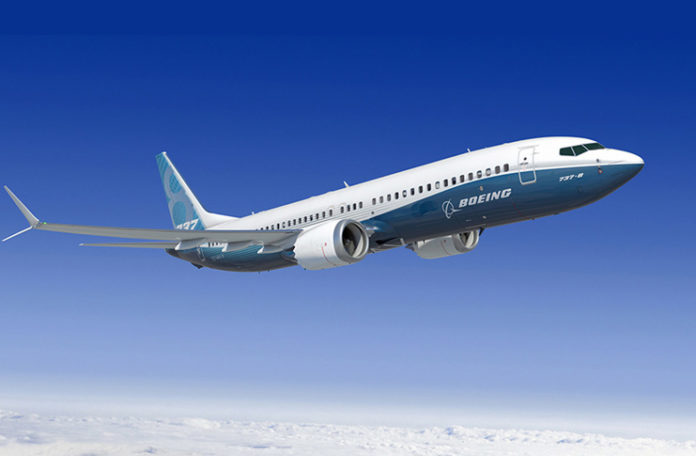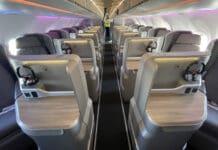
TravelingForMiles.com may receive commission from card issuers. Some or all of the card offers that appear on TravelingForMiles.com are from advertisers and may impact how and where card products appear on the site. TravelingForMiles.com does not include all card companies or all available card offers.
Some links to products and travel providers on this website will earn Traveling For Miles a commission that helps contribute to the running of the site. Traveling For Miles has partnered with CardRatings for our coverage of credit card products. Traveling For Miles and CardRatings may receive a commission from card issuers. Opinions, reviews, analyses & recommendations are the author’s alone and have not been reviewed, endorsed, or approved by any of these entities. For more details please see the disclosures found at the bottom of every page.
Ed Pierson, a former senior manager at Boeing and a key witness at the congressional hearings that investigated the issues that led to the two disasters involving Boeing 737 MAX aircraft, has suggested that although the US has recently cleared the aircraft to return to the skies and although the European authorities are set to do the same this week, issues surrounding the 737 MAX have not been fully addressed.
I’m not going to delve into the minutia of the 737 MAX saga as it’s a story that has been well documented (in brief, Boeing was lazy, slapdash, and negligent while the FAA displayed stunning incompetence) so I’m just going to report on what I’ve been reading over the weekend.
Brief Background
Pierson worked at Boeing’s base in Renton and held a senior role within the 737 development team between 2015 and 2018. In testimony that he gave before the House Transportation Committee in 2018 and 2019, Pierson said that what he saw around him on the 737 production line led him to tell his superiors that he was reluctant to allow his family to travel on Boeing aircraft. He also described conditions in the Boeing plant as chaotic and dysfunctional and confirmed that staff was under immense pressure to assemble aircraft as quickly as possible.
The Claims
In a paper published last Thursday, Pierson claims that the issues surrounding the 737 MAX were not limited to the notorious MCAS control system but also included manufacturing defects in other areas of the aircraft that have not been sufficiently addressed so far.
Pierson points to the fact that the reports into the accidents have stated that the 737 MAX aircraft that were involved in the two disasters had suffered from problems and anomalies in areas other than the MCAS system in the days and weeks leading up to the tragedies (problems and anomalies that Pierson puts down to failures in the production of the aircraft), and he claims that some of the issues seen in the aircraft may have been symptoms of flaws in the aircraft’s complex wiring systems and not simply an issue with MCAS.
Per Pierson’s paper:
55 days after delivery, the Lion Air airplane began experiencing intermittent problems with the flight control system. The Air Data Inertial Reference Unit (ADIRU) detected a problem with the Angle of Attack system and generated an “Angle of Attack is Out of Range” message.
The new airplane had other technical problems described in the accident investigation report besides the flight control system. For example, the Aircraft Flight and Maintenance Log (AFML) has an entry regarding an electrical system abnormality that resulted in the illumination of the aircraft’s STANDBY PWR OFF light followed by the tripping of six circuit breakers.
Over the course of several weeks leading up to the accident, Lion Air maintenance personnel performed troubleshooting using the airplane’s Onboard Maintenance Function (OMF). They were faced with a multitude of maintenance messages including: “AD DATA INVALID”, “STALL WARNING SYS L”, “ADIRU-L ADR DATA SIGNAL IS INVALID”, “ANGLE OF ATTACK SIGNAL IS OUT OF RANGE”, “AIR DATA SIGNALS FROM THE ADIRU-L ARE INVALID”, “AIR DATA INVALID” and “AOA SIGNAL FAIL”.
In addition to all the maintenance messages, on October 26th the AFML notes problems on the Captain’s Primary Flight Display (PFD). Over the next few days, instead of the normal speed and altitude indications, the pilots encountered several intermittent faults including SPD (speed) and ALT (altitude) flags; illumination of SPEED TRIM and MACH TRIM lights; and the disconnection of the Auto-Throttle on takeoff. Pilots depend on accurate speed and altitude information especially during takeoffs, landings, and while flying in instrument meteorological conditions. These repetitive faults are telltale signs of system failures.
As further proof of sub-standard workmanship on the 737 MAX production line, Pierson’s paper points out that it was faulty sensors that led directly to the two fatal disasters and then asks why aircraft that were, essentially, fresh from the production line, were fitted with faulty equipment if the production line was operating as it should.
The paper goes on to say the following:
“Even after the second crash, after the grounding, and as accident investigators were still investigating, the company produced large numbers of MAX airplanes (a “reduction” down to 42 airplanes per month) throughout 2019. Meanwhile production quality problems continued to surface. Since June 2019, several alarming production quality defects have come to light including defective slat tracks, deficient aircraft wiring shielding around the engines, and widespread foreign object debris (FOD) in fuel tanks—a crystal clear sign of an unhealthy and dangerous production environment.”
Assuming all of that to be true, that doesn’t show Boeing in a very good light.
Overall
All in all, the whole point of Pierson’s paper isn’t so much to point out the apparent deficiencies in Boeing’s production line (he’s already been doing that for the past few years) but to point out that while regulators around the world have been concentrating on making sure that Boeing’s MCAS system doesn’t put any more aircraft into irrecoverable nosedives, they have not done sufficient work to ensure that the 737 MAX is free from a variety of other anomalies and glitches, and they have not done enough work to ensure than the deficiencies on the production line that created these issues have been rectified.
I’m not an engineer or an expert in aircraft design, manufacture, and maintenance so I’m not in a position to comment on the veracity of Pierson’s statements and the conclusions that his paper draws. However, from the standpoint of a layperson who has read what Pierson has to say, I can say that I don’t have as much confidence as I would like to have in the thoroughness of the work carried out by Boeing and the various regulatory bodies since the two disasters.
I hope that all necessary lessons have been learned, but it will take more than hope to get me to fly in the 737 MAX if an alternative option is open to me.
















